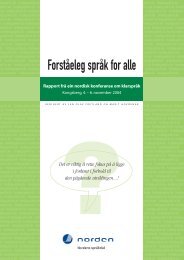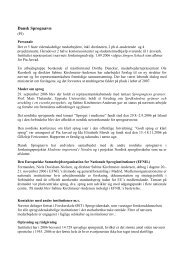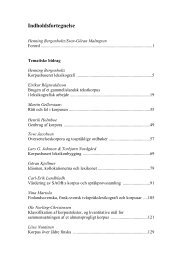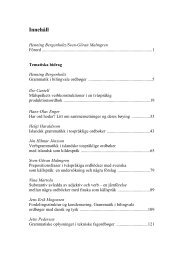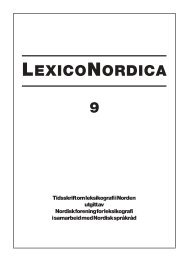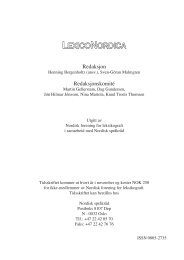- Page 1 and 2: L EXICON EXICO ORDICA 13-2006 Redak
- Page 3 and 4: Icke-tematiska bidrag Satu Tanner E
- Page 5 and 6: Henning Bergenholtz & Sven-Göran M
- Page 7 and 8: forrådet i Riksmålsordboken delvi
- Page 9: Vi vil minde om temaerne for de fø
- Page 13 and 14: 10 tidspunket da språket fungerer
- Page 15 and 16: 12 ikkje var sosialt snevert basert
- Page 17 and 18: 14 krigen. Arbeidsvillig står ikkj
- Page 19 and 20: 16 er frå 2005. (Som hovudredaktø
- Page 21 and 22: 18 NO markerer ikkje første og sis
- Page 23 and 24: 20 teriale, nemleg etablerte (gamle
- Page 25 and 26: 22 tydingar, mens tydingsgruppe 1 e
- Page 27 and 28: Henrik Andersson ODS - træk af en
- Page 29 and 30: skulle renoncere på fuldstændighe
- Page 31 and 32: ordets ældste betydning, vil man k
- Page 33 and 34: ønsket, den skulle have: Den blev
- Page 35 and 36: og fravalget af selvstændige under
- Page 37 and 38: i ODS. Dahlerups begrundelse for at
- Page 39 and 40: Folk, der udtrykker sig uden unødi
- Page 41 and 42: Litteratur Ordbøger Den Danske Ord
- Page 43 and 44: 42 av stavning med ä av kort e-lju
- Page 45 and 46: 44 ORKESTER … [jfr d. orkester, t
- Page 47 and 48: 46 Presentationsordningar Metoden f
- Page 49 and 50: 48 traditionen av logiskt rekonstru
- Page 51 and 52: 50 mologiska principen. Etymologin
- Page 53 and 54: 52 tydelsernas kronologi och tar i
- Page 55 and 56: 54 Lundbladh, Carl-Erik, 1997: Etym
- Page 57 and 58: 56 och som därför med större sä
- Page 59 and 60: 58 Eller med Hans Jonssons (1983:15
- Page 61 and 62:
60 excerperingen därefter minskade
- Page 63 and 64:
62 Rückersköld (1725-1805) var ve
- Page 65 and 66:
64 god tvåa kommer Sigfrid Siwertz
- Page 67 and 68:
66 innebär det ca 50. Urvalet best
- Page 69 and 70:
68 Anki Mattisson ordbokschef Svens
- Page 71 and 72:
70 ONP at anføre mange latinske pa
- Page 73 and 74:
72 hovedsagelig ved OED, tenderer m
- Page 75 and 76:
74 bevæge sig fra det generelle ti
- Page 77 and 78:
76 målet, men en sådan sammenkobl
- Page 79 and 80:
78 modtagerkreds udvidet, og der sk
- Page 81 and 82:
80 OED = The Oxford English Diction
- Page 84 and 85:
Fffffffffff Frrrttttt ggggFFffff 83
- Page 86 and 87:
Merete K. Jørgensen Gammeldansk Or
- Page 88 and 89:
1.2. Den enkelte seddel Fig. 1 Teks
- Page 90 and 91:
kilde registreret. Disse oplysninge
- Page 92 and 93:
Fig. 4 De oplysninger, der på denn
- Page 94 and 95:
For det fjerde kan projektet i frem
- Page 96 and 97:
Gammeldansk Ordbog vil også kunne
- Page 98 and 99:
Ordbog over det danske Sprog (ODS)
- Page 100 and 101:
100 lekterna (murteiden taistelu).
- Page 102 and 103:
102 4. Redigeringsarbetet Datorn ha
- Page 104 and 105:
104 Under 1600-talet utkom tre s.k.
- Page 106 and 107:
106 strängen skall formuleras. Man
- Page 108 and 109:
108 också de tre psalmböckerna. A
- Page 110 and 111:
110 hänvisningsartiklar enligt beg
- Page 112 and 113:
112 Pipliakielestä kirjakieleksi.
- Page 114 and 115:
114 betar med att rekonstruera Söd
- Page 116 and 117:
116 I det teoretiska perspektiv som
- Page 118 and 119:
118 Anna Nordling (2002) beskriver
- Page 120 and 121:
120 TABELL 1. Vokalbalans i Sdw kor
- Page 122 and 123:
122 I tabell 2 återges i schematis
- Page 124 and 125:
124 förra delen har excerperats fl
- Page 126 and 127:
126 allra högsta grad de ovan anty
- Page 128 and 129:
128 Reichmann, Oskar 1990: Das Spra
- Page 130 and 131:
130 eldre enn ordbokens samtidsspr
- Page 132 and 133:
132 Ømålsordbogen skal altså ikk
- Page 134 and 135:
134 ikke noget nærmere om hvordan
- Page 136 and 137:
136 ældre og en yngre betydning (
- Page 138 and 139:
138 5. Det diakrone og afgrænsning
- Page 140 and 141:
140 I det hele taget virker det som
- Page 142 and 143:
142 høvender er medtaget i ordboge
- Page 144 and 145:
144 ordbog, men man forsøger i pri
- Page 146 and 147:
Sv. Eegholm-Pedersen Holbergordboge
- Page 148 and 149:
Ordbogstype, tekstkorpus, lemmabest
- Page 150 and 151:
151 varetaget af trænede filologer
- Page 152 and 153:
153 betyder det ord, den frase i da
- Page 154 and 155:
155 nævnte artikler, men der føje
- Page 156 and 157:
157 måske nok en diskutabel period
- Page 158 and 159:
159 gen er i øvrigt som i ODS hier
- Page 160 and 161:
161 dog med prioritering af de kend
- Page 162 and 163:
163 fatterordbog fra nordisk sprogo
- Page 164 and 165:
165 Men lad os resumere og konklude
- Page 166 and 167:
167 Nordisk leksikografisk ordbok (
- Page 168 and 169:
Satu Tanner En dokumentation av det
- Page 170 and 171:
De karelska dialekterna enligt den
- Page 172 and 173:
173 vapen. Det var folkresningar i
- Page 174 and 175:
175 finskt skriftspråk och en nufi
- Page 176 and 177:
177 och latinska tecken. På 1930-t
- Page 178 and 179:
179 och undergrupperna är markerad
- Page 180 and 181:
181 Det karelska ordet ryssä anvä
- Page 182 and 183:
183 Band 3. l983. l-n. sidorna 1-58
- Page 184 and 185:
186 kunne vælge at kalde en af fun
- Page 186 and 187:
188 sådan måde, at brugerne selv
- Page 188 and 189:
190 Og en virkelig produktionsordbo
- Page 190 and 191:
192 sagtens stole på, brugeren ken
- Page 192 and 193:
194 • Som dokumentationsordbog og
- Page 194 and 195:
196 Bergenholtz, Henning/Sven Tarp
- Page 196 and 197:
198 mindre føler Bergenholtz/Vrang
- Page 198 and 199:
200 en interessant mulighed. Mere o
- Page 200 and 201:
202 mentarisk udtømmende). DEN DAN
- Page 202 and 203:
204 ning, nemlig den aktivitet at l
- Page 204 and 205:
206 oplysningstype/emne sider andel
- Page 206 and 207:
208 ORDBOG OVER DET DANSKE SPROG =
- Page 208 and 209:
210 menteret bl.a. i nordiske skrif
- Page 210 and 211:
212 hvorved hver konstruktion - som
- Page 212 and 213:
214 2.2. Ordbogens anden del I ordb
- Page 214 and 215:
216 i bagdelen], hvor de alternativ
- Page 216 and 217:
218 Det første kriterium bygger p
- Page 218 and 219:
220 FIGUR 11. Resultat af søgning
- Page 220 and 221:
222 FIGUR 13. Det dansk→islandske
- Page 222 and 223:
224 FIGUR 15. Vindue der viser resu
- Page 224 and 225:
226 ærgre sig over den manglende f
- Page 226 and 227:
228 Internetsider http://kollokatio
- Page 228 and 229:
230 den aktuelle ordbokens typologi
- Page 230 and 231:
232 behandlet som uavhengige enhete
- Page 232 and 233:
234 ene, men den begrenser ikke på
- Page 234 and 235:
236 Litteratur Bergenholtz, Henning
- Page 236 and 237:
238 gjort greie for av Anne Duekild
- Page 238 and 239:
240 7. Nye bruksdøme (t d nedbryde
- Page 240 and 241:
Lars-Gunnar Larsson & Anki Mattisso
- Page 242 and 243:
245 måste dock sättas för RES fo
- Page 244 and 245:
247 envist, neka blankt, verkar sak
- Page 246 and 247:
249 RES är omsorgsfullt korrekturl
- Page 248 and 249:
252 ne er udarbejdet i et brugerper
- Page 250 and 251:
254 anføres, at det sandsynlige an
- Page 252 and 253:
256 2.2. Forståelse af danske og f
- Page 254 and 255:
258 brugersituationer - og dermed o
- Page 256 and 257:
260 for ordbøgerne. Gevinsten vil
- Page 258 and 259:
262 skifte holdning changer d’att
- Page 260 and 261:
264 ord i henhold til dansk og fran
- Page 262 and 263:
266 kejtet holdning attitude gauche
- Page 264 and 265:
268 6. Epilog Vi har først påvist
- Page 266 and 267:
270 Bilag - 49 ordbogsfunktioner Ne
- Page 268 and 269:
272 46.produktion af danske fagspro
- Page 270 and 271:
274 minst i Sverige väcker respekt
- Page 272 and 273:
276 3. En genomläsning av SAOB/34,
- Page 274 and 275:
278 Det är dock i första hand spr
- Page 276 and 277:
280 den svenska eller västerländs
- Page 278 and 279:
282 5. Om stilen i SAOB:s definitio
- Page 280 and 281:
284 tjänar att upprepas: SAOB-reda
- Page 282 and 283:
286 I det følgende vil centrale om
- Page 284 and 285:
288 2.2. Omvending og supplering N
- Page 286 and 287:
290 ne oversættes ud fra de genere
- Page 288 and 289:
292 Abfall […] 1. (landskabets) f
- Page 290 and 291:
294 Det samme gælder opslag af fø
- Page 292 and 293:
296 TYSK-DANSK ORDBOG (2005) Anmeld
- Page 294 and 295:
298 5. Udtale Udtaleangivelser var
- Page 296 and 297:
300 Der henvises i mange tilfælde
- Page 298 and 299:
302 krebserregend adj. (med.) kræf
- Page 300 and 301:
304 adskilt fra andet sammensætnin
- Page 302 and 303:
306 Litteratur Ordbøger AMTLICHE R
- Page 304 and 305:
308 Mogensen, Jens Erik 2005c: Orth
- Page 306 and 307:
310 utgjevingstidspunktet er det
- Page 308 and 309:
312 leg å sjå om det er mellomrom
- Page 310 and 311:
314 det delt inn hovudtydingar note
- Page 312 and 313:
316 Lemmaseleksjonen - pragmatiske
- Page 314 and 315:
318 imot attare dekket. Vi må alts
- Page 316 and 317:
320 liggja ei medviten vurdering ba
- Page 318 and 319:
322 Når det gjeld fagspråklege kj
- Page 320 and 321:
324 Avslutning Utgjevarane av Norsk
- Page 322 and 323:
326 Lille leksikon om nordisk mytol
- Page 324 and 325:
328 har fået med at klæbe cd-romm
- Page 326 and 327:
330 Den første sætning er forstå
- Page 328 and 329:
332 Under Udgaver i oversættelse,
- Page 330 and 331:
334 optræder som opslagsord, men e
- Page 332 and 333:
336 mere brugervenligt, for hvordan
- Page 334 and 335:
338 Bibliografi Ordbøger Christian
- Page 336 and 337:
Finn Stefánsson Bemærkninger til
- Page 338 and 339:
343 scoop. Dermed ikke sagt, at bog
- Page 340 and 341:
345 stof i mytologien, der har en g
- Page 342 and 343:
Thomas Troelsgård Russisk tur-retu
- Page 344 and 345:
349 er medtaget hos Harrit/Krasnova
- Page 346 and 347:
351 I de senere år har de såkaldt
- Page 348 and 349:
353 hvor forbindelser der ligner hi
- Page 350 and 351:
355 Ønsket om at spare plads og om
- Page 352 and 353:
357 fornuftige løsning er den dire
- Page 354 and 355:
Meddelanden Meddelelser fra formand
- Page 356 and 357:
361 opmærksom på at der ikke vil
- Page 358:
8. Særlige angivelser: leksikograf


